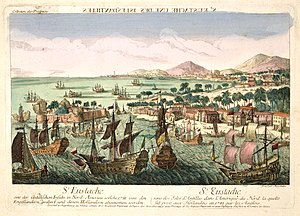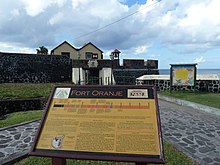
The Fourth Anglo-Dutch War was a conflict between the Kingdom of Great Britain and the Dutch Republic. The war, contemporary with the War of American Independence (1775–1783), broke out over British and Dutch disagreements on the legality and conduct of Dutch trade with Britain's enemies in that war.

Admiral George Brydges Rodney, 1st Baron Rodney, KB, was a British naval officer. He is best known for his commands in the American War of Independence, particularly his victory over the French at the Battle of the Saintes in 1782. It is often claimed that he was the commander to have pioneered the tactic of breaking the line.

Sint Eustatius, known locally as Statia, is an island in the Caribbean. It is a special municipality of the Netherlands.

The Battle of the Saintes, also known as the Battle of Dominica, was an important naval battle in the Caribbean between the British and the French that took place 9–12 April 1782. The British victory was considered their greatest over the French during the American Revolutionary War.
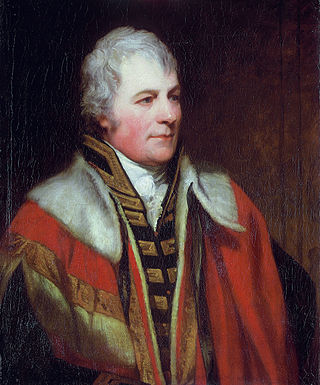
Admiral William Carnegie, 7th Earl of Northesk was a British naval officer who served during the American Revolutionary War, French Revolutionary War, and Napoleonic Wars. While in command of HMS Monmouth he was caught in the Nore Mutiny of 1797 and was the officer selected to relay the demands of the mutineers to George III. He most notably served as third-in-command of the Mediterranean Fleet at the Battle of Trafalgar in HMS Britannia. He later became Rear-Admiral of the United Kingdom and Commander-in-Chief, Plymouth.

The Battle of Saint Kitts, also known as the Battle of Frigate Bay, was a naval battle fought on 25 and 26 January 1782 during the American Revolutionary War between a British fleet under Rear Admiral Sir Samuel Hood and a larger French fleet under the Comte de Grasse.

Admiral Sir Richard Hussey Bickerton, 2nd Baronet, KCB, was a British naval officer. He was born in Southampton, the son of Vice-admiral Sir Richard Bickerton and first served aboard HMS Medway in June 1774, in the Mediterranean. His first command came in March 1779 when he was given HM Sloop Swallow as a reward for his part in an engagement with a much larger opponent. Bickerton later joined Rodney's squadron in the West Indies where he took part in the capture of Sint Eustatius in 1781. Making post captain on 8 February 1781, he took temporary command of HMS Invincible and fought in her at the Battle of Fort Royal on 29 April 1781.

The Battle of Fort Royal was a naval battle fought off Fort Royal, Martinique in the West Indies during the Anglo-French War on 29 April 1781, between fleets of the British Royal Navy and the French Navy. After an engagement lasting four hours, the British squadron under Admiral Samuel Hood broke off and retreated. Admiral de Grasse offered a desultory chase before seeing the French convoys safe to port.

Fénix was an 80-gun ship of the line (navio) of the Spanish Navy, built by Pedro de Torres at Havana in accordance with the system laid down by Antonio Gaztaneta launched in 1749. In 1759, she was sent to bring the new king, Carlos III, from Naples to Barcelona. When Spain entered the American Revolutionary War in June 1779, Fénix set sail for the English Channel where she was to join a Franco-Spanish fleet of more than 60 ships of the line under Lieutenant General Luis de Córdova y Córdova. The Armada of 1779 was an invasion force of 40,000 troops with orders to capture the British naval base at Portsmouth.

Johannes de Graaff (1729–1813), also referred to as Johannis de Graeff in some documents, was a Dutch Governor of Sint Eustatius, Saba and Sint Maarten in the Netherlands Antilles during the difficult time of the American Revolutionary War.

The Invasion of Tobago was a French invasion of the British-held island of Tobago during the Anglo-French War. On May 24, 1781, the fleet of Comte de Grasse landed troops on the island under the command of General Marquis de Bouillé. By June 2, 1781, they had successfully gained control of the island.

The Dutch West Indies campaign was a series of minor conflicts in 1781 and 1782, in the Fourth Anglo-Dutch War and the American Revolutionary War. Following Great Britain's declaration of war on the Dutch Republic in December 1780, British Admiral George Brydges Rodney, the commander of the Royal Navy in the West Indies, was notified by a fast-sailing packet ship of the declaration. He immediately acted to ensure control over as many of the Dutch colonies as possible, capturing Sint Eustatius, a vital entrepot of French and Dutch trade between their colonies and Europe, in early February 1781. He also captured Saba and Sint Maarten, and orchestrated the capture of the Dutch colonial outposts of Berbice, Demerara, and Essequibo in South America. A planned expedition by Samuel Hood against Curaçao was called off on rumors that a French fleet was approaching. A French expedition in 1782 captured Demerara and Essequibo, although the fate of the other colonies were settled at the conclusion of the war.

The capture of Demerara and Essequibo was a French military expedition carried out in January 1782 as part of the American Revolutionary War. In 1781 Admiral Lord Rodney sent two sloops from his fleet at Sint Eustatius to take possession of the Dutch colonies of Essequibo and Demerara. In 1782 the French successfully took possession of these settlements, compelling British Governor Robert Kingston to surrender. The Treaty of Paris in 1783 restored these territories to the Dutch.
Samuel Granston Goodall was an officer of the Royal Navy who saw service during the Seven Years' War, the American War of Independence and the French Revolutionary Wars in a career that spanned 50 years, rising to the rank of Admiral of the White.

HMS Prince William was a 64-gun third-rate ship of the line of the Royal Navy. She had previously been Guipuzcoano, an armed 64-gun ship of the Spanish (Basque) mercantile Guipuzcoan Company of Caracas. She was also known by the religious name of Nuestra Señora de la Asunción.

The Anglo-French War, also known as the War of 1778 or the Bourbon War in Britain, was a military conflict fought between France and Great Britain, sometimes with their respective allies, between 1778 and 1783. As a consequence, Great Britain was forced to divert resources used to fight the American War of Independence to theatres in Europe, India and the West Indies, and to rely on what turned out to be the chimera of Loyalist support in its North American operations. From 1778 to 1783, with or without their allies, France and Britain fought over dominance in the English Channel, the Mediterranean, the Indian Ocean and the Caribbean.
John May built Mars at the naval dockyard at Amsterdam in 1769 as a fifth rate for the Dutch Navy. The British Royal Navy captured her on 3 February 1781 at Saint Eustatia. The Navy took her into service as HMS Mars, but sold her on 25 March 1784. Richard Bush purchased Mars, retained her name, and had her fitted as an East Indiaman. Adams repaired her and took her measurements in 1786. She sailed to China in April 1786 for the British East India Company (EIC) and was wrecked in December 1787 shortly after her return to Britain.

The action of 4 February 1781 was a minor naval engagement that occurred on 4 February 1781 off Sombrero, Anguilla, between a British force of two ships of the line and one frigate under the command of Captain Francis Reynolds-Moreton, 3rd Baron Ducie and a Dutch ship of the line escorting thirty merchant ships under the command of Rear-Admiral Willem Krull, and resulted in the capture of all Dutch vessels present by the British. The battle occurred soon after a British expeditionary force under the command of Admiral George Brydges Rodney had captured the Dutch colony of Sint Eustatius during the opening stages of the Fourth Anglo-Dutch War, a conflict resulting from tensions between the Kingdom of Great Britain and the Dutch Republic over Dutch support for the American rebels during the Revolutionary War.
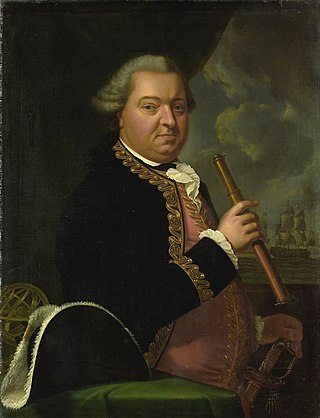
Willem Krul, was a vice-admiral in the Dutch Navy in the latter 18th century, and then commander of the Dutch ship of the line Mars, during the American Revolutionary War. He was also known as Adrianus Hendrik Willem Krul. After serving in various assignments about the European Atlantic coast Krul served in his final naval assignment at Saint Eustatius, a Dutch possession in the West Indies, during which time he lost his life while engaged in a naval battle with the British, making him a national hero in the Netherlands.
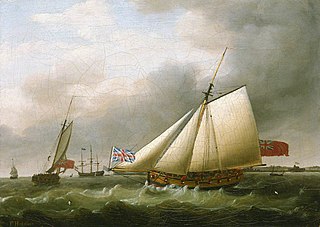
HMS Fly was a cutter that the Royal Navy purchased in 1778. The French Navy captured Fly in June 1781.
